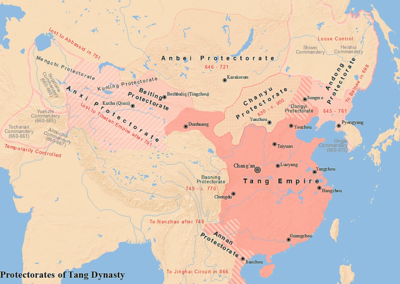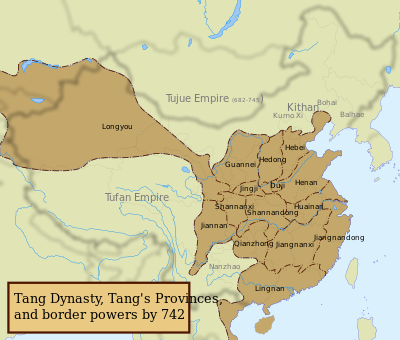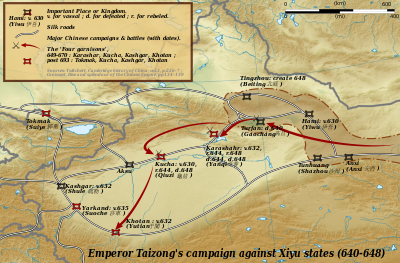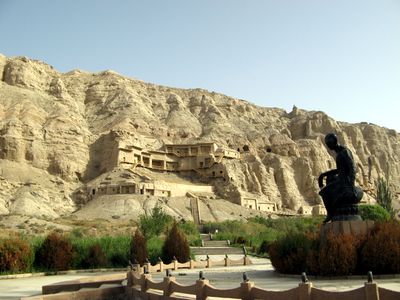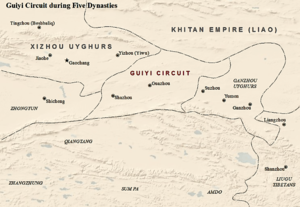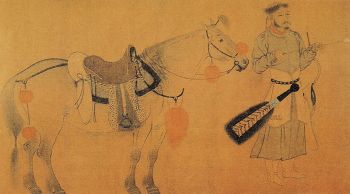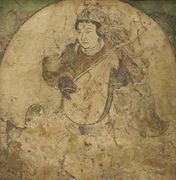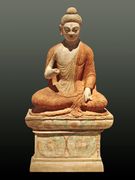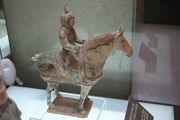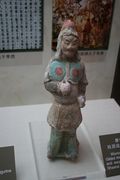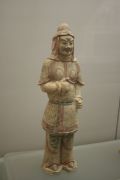المحمية العامة لإخضاع الغرب
| المحمية العامة لإخضاع الغرب | |||
|---|---|---|---|
| الصينية التقليدية | 安西大都護府 | ||
| الصينية المبسطة | 安西大都护府 | ||
| المعنى الحرفي | Pacify-West Grand Metropolitan-Protection Prefecture/Office | ||
| |||
| المحمية لإخضاع الغرب | |||
| الصينية التقليدية | 安西都護府 | ||
| الصينية المبسطة | 安西都护府 | ||
| المعنى الحرفي | Pacify-West Metropolitan-Protection Prefecture/Office | ||
| |||
جزء من سلسلة عن |
|---|
| تاريخ شينجيانگ |
 |
المحمية العامة لإخضاع الغرب ( Protectorate General to Pacify the West؛ آنشي، المحمية الكبرى)، وفي البداية محمية إخضاع الغرب (محمية آنشي)، كانت محمية (640 – ح. 790) أسستها أسرة تانگ in 640 to control the حوض تريم.[1] The head office was first established at the prefecture of Xi, now known as Turpan, but was later shifted to Qiuci (Kucha) and situated there for most of the period.[2] The Four Garrisons of Anxi in Kucha, Khotan, Kashgar, and Karashahr were installed between 648 and 658 as garrisons under the western protectorate. In 659 Soghd, Ferghana, Tashkent, Bukhara, Samarkand, Balkh, Herat, Kashmir, the Pamirs, Tokharistan, and Kabul all submitted to the protectorate under Emperor Gaozong of Tang.[3][4][5][6][7] After the An Lushan Rebellion the office of Protector General was given to Guo Xin who defended the area and the four garrisons even after communication had been cut off from Chang'an by the Tibetan Empire. The last five years of the protectorate are regarded as an uncertain period in its history, but most sources agree that the last vestiges of the protectorate and its garrisons were defeated by Tibetan forces by the year 790, ending nearly 150 years of Tang influence in central Asia.
التاريخ

القرن السابع
The Western Regions during the Tang era were known as Qixi (磧西). Qi refers to the Gobi Desert while Xi refers to the west.
In 632 the oasis kingdoms of Khotan (Yutian) and Shule (Kashgar) submitted to the Tang dynasty as vassals.[8]
In 635 Yarkand (Shache) submitted to the Tang dynasty.[8]
On 19 September 640 Hou Junji of Tang conquered Gaochang and set up Xi Prefecture (西州) in its place.[9][10] Xi Prefecture became the seat of the Anxi Protectorate on 11 October. Qiao Shiwang became the first protector general of the Anxi and served from 640-642. Guo Xiaoke received the next post and served from 640-648.
By 644 Karasahr was also conquered, and was known to the Chinese as Yanqi. Aksu (Gumo) was garrisoned by Tang troops.[11]
In 648, the Tang conquered Kucha, known to the Chinese as Qiuci, and made it the new seat of Anxi under the governance of Chai Zhewei from 649-651.[10]
By 650 the entire Western Region had submitted to Tang authority.[11]
In 651 the seat was moved back to Xi Prefecture where it remained under the governance of Qu Zhizhan from 651-658.[10]
In 656 the Tibetan Empire attacked Lesser Bolü in Gilgit southwest of the protectorate.[12]
In 658 the seat was moved back to Qiuci after Su Dingfang defeated the Western Turkic Khaganate. Its title was changed to "Grand Protectorate" and granted governorship of former Western Turkic territories, which were further separated into the Mengchi and Kunling protectorates.[10]
In 660 the Tibetan Empire and their Turkic allies attacked Shule. The Tibetan Empire also attacked Wakhan to the protectorate's southwest.[12] When the Tang general boasted of the size of his army, Gar Tongtsen Yulsung's son responded in the following manner:
There is no disputing the matter of numbers. But many small birds are the food of a single hawk, and many small fish are the food of a single otter. A pine tree has been growing for a hundred years, but a single axe is its enemy. Although a river runs ceaselessly, it can be crossed in a moment by a boat six feet long. Although barley and rice grow over a whole plain, it is all the grist of a single mill. Although the sky is filled with stars, in the light of a single sun they are nothing.[13]
In 663 the Tibetan Empire conquered Tuyuhun southeast of the protectorate.[12] They also attacked Yutian but were repelled.[14]
In 665 the Tibetan Empire and Turkic allies attacked Yutian.[12] The conflict between the Tang and Tibetans was the primary context under which the story of a Khotanese princess striving to rescue Khotan from destruction was formulated. One passage of the story in prayer form reads:
When the red-faced ones and the Chinese battle each other, may Khotan not be destroyed. When monks come from other countries to Khotan, may they not be treated dishonourably. May those who flee here from other countries find a place to stay here, and help to rebuild the great stupas and monastic gardens that have been burned by the red-faced ones.[15]
In 670 the Tibetan Empire routed a Tang army at the Battle of Dafei River and attacked Gumo as well as captured Qiuci. The protectorate's seat was moved to Suyab, known as Suiye to the Chinese, in modern Kyrgyzstan.[10][12]
In 673 the Tang consolidated control over the Wuduolu Turks living in the area that came to be known as Dzungaria. The Tang also captured Qiuci and established control over the Western Regions in the same year.[16]
In 677 the Tibetan Empire captured Qiuci. In the same year Ashina Duzhi, previously a Tang general tasked with controlling the Wuduolu Turks, rebelled and declared himself Onoq Khagan, ruler of all Turks.[17]
In 679 the Tang general, Pei Xingjian, defeated Ashina Duzhi as well as the Tibetans and established control over the Western Regions.[18]
In 686 Tang troops withdrew from the Four Garrisons after elements within the court argued for the decrease of military expenditures.[19]
In 687 the Tibetan Empire established control over the Western Regions.[20]
In 690 the Tibetan Empire defeated a Tang army at Issyk-Kul[20]
In 692 Tang troops under Wang Xiaojie pacified the Western Regions and established the Anxi Protectorate at Qiuci, where it would remain until the protectorate's demise around 790.[11][20][10][21] The importance of the Western Regions was well understood by the Tang court at this point. Its strategic significance is summarized by Cui Rong, an Imperial Diarist of the court:
If we cannot defend these garrisons, barbarians will surely come to destabilize the Western Regions. And various tribes south of the Nanshan Mountain [i.e., the Qilian and the Kunlun Mountains] would feel threatened. If they link up with one another, they would pose a threat to regions west of the Yellow River [i.e., present-day Gansu and Qinghai provinces]. Moreover, if they get in touch with the Turks in the north, our soldiers will be unable to crush them by crossing the Moheyan Desert [the desert northwest of Dunhuang] that extends over 2,000 li, where neither water nor grass can be found. The tribes [loyal to China] in Yizhou, Xiyzhou, Beiting [Beshbalik], and Anxi protectorates will all be eliminated.[20]
— Cui Rong
In 694 the Tibetan Empire attacked the Stone City (Charklik).[22]
القرن الثامن

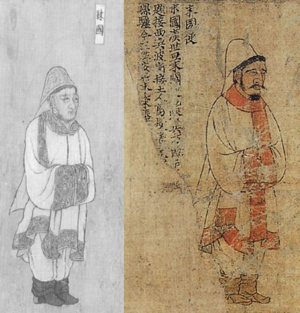
In 702 Wu Zetian set up the Beiting Protectorate in Ting Prefecture (Jimsar County) and granted it governorship over Yi Prefecture (Hami) and Xi Prefecture.[23]
In 708 the Turgesh attacked Qiuci.[24]
In 710 the Tibetan Empire conquered Lesser Bolü.[25]
Arab sources claim Qutayba ibn Muslim briefly took Kashgar from China and withdrew after an agreement[26] but modern historians entirely dismiss this claim.[27][28][29]
In 715 the Tibetan Empire attacked Fergana, a Tang vassal.[24]
In 717 the Tibetan Empire attacked Gumo and the Stone City.[30][31]
The Arab Umayyad Caliphate in 715 AD desposed Ikhshid, the king the Fergana Valley, and installed a new king Alutar on the throne. The deposed king fled to Kucha (seat of Anxi Protectorate), and sought Chinese intervention. The Chinese sent 10,000 troops under Zhang Xiaosong to Ferghana. He defeated Alutar and the Arab occupation force at Namangan and reinstalled Ikhshid on the throne.[32]
General Tang Jiahui led the Chinese to defeat the following Arab-Tibetan attack in the Battle of Aksu (717).[33] The attack on Aksu was joined by Turgesh Khan Suluk.[7] Both Uch Turfan and Aksu were attacked by the Turgesh, Arab, and Tibetan force on 15 August 717. Qarluqs serving under Chinese command, under Arsila Xian, a Western Turkic Qaghan serving under the Chinese Assistant Grand Protector General Tang Jiahui defeated the attack. Al-Yashkuri, the Arab commander and his army fled to Tashkent after they were defeated.[34][35]
In 719 the Turgesh captured Suiye.[24]
In 720 the Tibetan Empire seized the Stone City.[36] In the same year Tang bestowed titles upon the kings of Khuttal, Chitral, and Oddiyana[37]
In 722 Tang restored the king of Lesser Bolü to his throne.[36]
In 725 the king of Khotan (Yutian) rebelled but was immediately replaced with a Tang puppet by protectorate forces.[36]
In 726 the Turgesh attempted to engage in horse trade at Qiuci without prior authorization. The Turgesh Khagan Suluk used his marital relation with Princess Jiaohe to issue a decree ordering the Protector-General to engage in trade. However Princess Jiaohe was actually the daughter of Ashina Huaidao, and the Protector-General retorted: "How can an Ashina woman proclaim a decree to me, a military commissioner?!"[38] In response Suluk attacked Qiuci.[24]
In 727 and 728 the Tibetan Empire attacked Qiuci.[24]
In 737 the Tibetan Empire conquered Lesser Bolü.[30]
In 741 the Tibetan Empire sacked the Stone City.[39]
In 745 the Tang general Huangfu Weiming attacked the Stone City but suffered a major defeat.[40] According to Huangfu, the Stone City was one of the most heavily defended bastions of the Tibetan Empire:
Shih-pao is strongly defended. The whole Tibetan nation is guarding it. Now if we array our troops below it, we cannot capture it without several tens of thousands of [our] men being killed. I am afraid that what would be gained is not comparable to what would be lost.[41]
— Huangfu Weiming
In 747 the Tang general Gao Xianzhi captured Lesser Bolü.[24]
In 748 the Tang recaptured Suiye and destroyed it.[24]
In 749 Tang recovered the Stone City.[39]
In 750 the Tang intervened in a dispute between their vassal Fergana and the neighboring kingdom of Chach, located in modern Tashkent. The kingdom of Chach was sacked and their king was taken back to Chang'an, where he was executed.[24] In the same year Tang also defeated Qieshi in Chitral and the Turgesh.[42]
In 751 Tang forces suffered a major defeat at the Battle of Talas against Abbasid and Karluk forces.[24] Although the Battle of Talas saw the limit of Tang expansion to the west, the importance of the defeat at the Battle of Talas has sometimes been exaggerated. Although the Tang army was defeated, the Arabs did not extend their influence into Xinjiang, and the Karluks remained amiable to the Tang. Some Karluks converted to Islam, but the vast majority did not until the mid 10th century under Sultan Satuq Bughra Khan of the Kara-Khanid Khanate. The long term strategic importance of Talas was overshadowed later on by the An Lushan Rebellion, which devastated the Tang homeland. It is now understood as the primary cause for the Tang retreat from Central Asia.[43][44][45][46][47][48][49][50]
In 754 Tang forces defeated Baltistan (Greater Bolü) and Tibetan forces.[42]
In 755 the An Lushan Rebellion occurred and the Tang dynasty withdrew 200,000 soldiers from the Western Regions to protect the capital.[42]
In 763 the Tibetan Empire conquered Yanqi.[51] In the same year the Tang capital was briefly taken by the Tibetans before they were forced to retreat.[52]
In 764 the Tibetan Empire invaded the Hexi Corridor and conquered Liang Prefecture,[53] cutting off the Anxi and Beiting protectorates from the Tang dynasty. However Anxi and Beiting were left relatively unmolested under the leadership of Guo Xin and Li Yuanzhong.[54]
In 780 Guo Xin and Li Yuanzhong were officially made protectorate generals after sending secret messages to Emperor Dezong of Tang.[55]
In 787 the Tibetan Empire conquered Qiuci.[51]
In 789 the monk Wukong passed through Shule, Yutian, Gumo, Qiuci, Yanqi, and Ting Prefecture and found that they all had Chinese commanders and were free from Tibetan or Uyghur control. This contradicts the previous conquests of Yanqi and Qiuci by the Tibetan Empire in 763 and 787, assertions made by Yuri Bregel in his An Historical Atlas of Central Asia.[56]
In 792 the Tibetan Empire conquered Yutian.[51]
It is unclear what happened to Shule (قشغر), Shache (Yarkand), or Gumo (Aksu).[51] According to O. Pritsak, Kashgar came under Karluk domination around this time, but this is disputed by Christopher I. Beckwith.[57]
بعد الهيمنة التبتية
Regarding Khurasan and its proximity to the land of China, between the latter and Sogdiana there is a journey of two months. The way, however, is via a forbidding desert of unbroken sand dunes in which there are no water sources and no river valleys, with no habitation nearby. That is what prevents the people of Khurasan from launching an assault on China. Turning to the part of China lying in the direction of the setting sun, namely the place known as Bamdhu, this is located on the borders of Tibet, and fighting never ceases there between the Chinese and the Tibetans.[58]
— Abu Zayd Al-Sirafi
Of the four garrisons that made up the defunct Anxi Protectorate, all eventually ended up freeing themselves or coming under the dominion of other powers by the mid-9th century.
Karasahr and Kucha were occupied by the Kingdom of Qocho in 843.[59]
Kashgar came under the dominion of the Kara-Khanid Khanate. The earliest approximate date of around the late 8th or early 9th century is disputed, but it was likely before 980.[60]
Khotan regained its independence in 851.[61] By 1006 it was also conquered by the Kara-Khanid Khanate.[62]
قائمة الحماة العموميين
List of grand and assistant protector generals of the Protectorate General to Pacify the West (Anxi):[63]
المحمية:
- Qiao Shiwang (喬師望) 640–642
- Guo Xiaoke (郭孝恪) 642–649
- Chai Zhewei (柴哲威) 649–651
- Qu Zhizhan (麴智湛) 651–658
المحمية الكبرى:
- Yang Zhou (楊胄) 658–662
- Su Haizheng (蘇海政) 662
- Gao Xian (高賢) 663
- Pilou Shiche (匹婁武徹) 664
- Pei Xingjian (裴行儉) 665–667
المحمية:
- Tao Dayou (陶大有) 667–669
- Dong Baoliang (董寶亮) 669–671
- Yuan Gongyu (袁公瑜) 671–677
- Du Huanbao (杜懷寶) 677–679,
- Wang Fangyi (王方翼) 679–681
- Du Huanbao (杜懷寶) 681–682
- Li Zulong (李祖隆) 683–685
المحمية الكبرى:
- Wang Shiguo (王世果) 686–687
- Yan Wengu (閻溫古) 687–689
المحمية:
- Jiu Bin (咎斌) 689–690
- Tang Xiujing (唐休璟) 690–693
المحمية الكبرى:
- Xu Qinming (許欽明) 693–695
- Gongsun Yajing (公孫雅靖) 696–698
- Tian Yangming (田揚名) 698–704
- Guo Yuanzhen (郭元振) 705–708,
- Zhou Yiti (周以悌) 708–709
- Guo Yuanzhen (郭元振) 709–710
- Zhang Xuanbiao (張玄表) 710–711
- Lu Xuanjing (呂玄璟) 712–716
- Guo Qianguan (郭虔瓘) 715–717,
- Li Cong (李琮) 716
- Tang Jiahui (湯嘉惠) 717–719,
- Guo Qianguan (郭虔瓘) 720–721
- Zhang Xiaosong (張孝嵩) 721–724
- Du Xian (杜暹) 724–726
- Zhao Yizhen (趙頤貞) 726–728
- Xie Zhixin (謝知信) 728
- Li Fen (李玢) 727–735
- Zhao Hanzhang (趙含章) 728–729
- Lu Xiulin (吕休琳) 729–730
- Tang Jiahui (湯嘉惠) 730
- Lai Yao (萊曜) 730–731
- Xu Qinshi (徐欽識) 731–733
- Wang Husi (王斛斯) 733–738
- Ge Jiayun (蓋嘉運) 738–739
- Tian Renwan (田仁琬) 740–741
- Fumeng Lingcha (夫蒙靈詧) 741–747
- Gao Xianzhi (高仙芝) 747–751
- Wang Zhengjian (王正見) 751–752
المحمية:
- Feng Changqing (封常清) 752–755
- Liang Zai (梁宰) 755–756
- Li Siye (李嗣業) 756–759
- Lifei Yuanli (荔非元禮) 759–761
- Bai Xiaode (白孝德) 761–762
- Sun Zhizhi (孫志直) 762–765
- Zhu Mou (朱某) 765-?
- Er Zhumou (爾朱某) 765-778
- Guo Xin (郭昕) 762–808
الذكرى
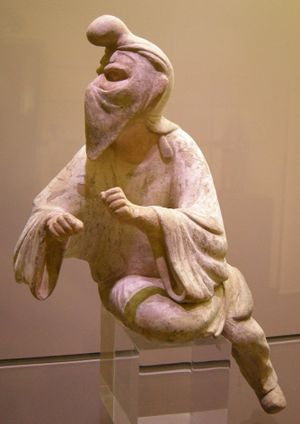
الآثار الطبيعية
In Xinjiang and the Chu valley in Central Asia, Tang era Chinese coins continued to be copied and minted after the Chinese left the area.[65][66] Coins with both Chinese and Karoshthi inscriptions have been found in the southern Tarim Basin.[67]
التأثير اللغوي
The military dominance of the Tang in Central Asia has been used as an explanation for the Turkic word for China, "Tamghaj", possibly derived from the "House of Tang" (Tangjia) instead of Tabgatch.[68]
التأثير الثقافي
Chinese arts and crafts such as the sancai "three color" glaze left a long lasting impression in Central Asia and Western Eurasia.[66]
In the Persian epic Shahnameh the Chin and Turkestan are regarded as the same. The Khan of Turkestan is called the Khan of Chin.[69][70][71]
Aladdin, an Arabic Islamic story which is set in China, may have been referring to Central Asia.[72]
التأثير السياسي
Steppe empires often utilized the prestige of the Tang by connecting themselves to the defunct dynasty. The Qara Khitan khans used the title of "Chinese emperor" while the Khara-Khanid khans called themselves Tabgach.[73] Tabgach Khan, or "Khan of China" was a common appellation among Khara-Khanid rulers.[74] Persian, Arab and other western Asian writers came to call China by the name "Tamghaj".[75]
In 1124 the westward migration of the Khitans under Yelü Dashi also consisted of a large population of Han Chinese, Balhae, Jurchen, Mongols, Khitan, in addition to the Xiao consort clan and the Yelü royal family[76] In the 12th century, the Qara Khitai defeated the Kara-Khanid Khanate and conquered their territory in Central Asia. The Khitan rulers, called "the Chinese" by Muslims, governed using Chinese as their official language as well as the Chinese style of imperial government. The effect of their administration was seen with respect and esteem due in part to China's status in Central Asia at the time.[77][78][79][80] The Chinese characteristics appealed to the Muslim Central Asians and helped validate Qara Khitai rule. Han Chinese population among them was comparatively small so it is unlikely that the Chinese characteristics were kept to appease them. Later the Mongols moved more Chinese into Beshbalik, Almaliq and Samarqand in Central Asia to work as artisans and farmers.[81]
The "image of China" played a key role in legitimizing the Khitan rule to the Central Asian Muslims. Prior to the Mongol invasions, the perception of China among Central Asian Muslims was an extremely civilized society, known for its unique script, its expert artisans, justice and religious tolerance. The Chinese, Turk, Arab, Byzantine, and Indian rulers were known as the world's "five great kings". The historical memory of Tang China was powerful enough that anachronistic expressions appeared in Muslim writings long after the end of the Tang. China was known as chīn (چين) in Persian and as ṣīn (صين) in Arabic while the Tang dynasty capital Changan was known as Ḥumdān (خُمدان).[82]
Some Muslim writers like Marwazī, Mahmud Kashghārī and Kashgari viewed Kashgar as part of China. Ṣīn [i.e., China] is originally three fold; Upper, in the east which is called Tawjāch; middle which is Khitāy, lower which is Barkhān in the vicinity of Kashgar. But know Tawjāch is known as Maṣīn and Khitai as Ṣīn" China was called after the Tuoba rulers of the Northern Wei by the Turks, pronounced by them as Tamghāj, Tabghāj, Tafghāj or Tawjāch. India introduced the name Maha Chin (greater China) which influenced the two different names for China in Persian as chīn and māchīn (چين ماچين) and Arabic ṣīn and māṣīn (صين ماصين), Southern China at Canton was known as Chin while Northern China's Chang'an was known as Machin, but the definition switched and the south was referred to as Machin and the north as Chin after the Tang dynasty. As a result of Tang China's control over Kashgar, some Kashghārī placed Kashgar within the definition of China, Ṣīn, whose emperor was titled as Tafghāj or Tamghāj, Yugur (yellow Uighurs or Western Yugur) and Khitai or Qitai were all classified as "China" by Marwazī while he wrote that Ṣīnwas was bordered by placed SNQU and Maṣīn.[83] Machin, Mahachin, Chin, and Sin were all names of China.[84] According to Fakhr al-Dīn Mubārak Shāh, "Turkestan", Balasagun, and Kashghar were identified with where Chīn (China) was located.[85]
Marwazī considered Transoxania to be a former part of China, retaining the legacy of Tang Chinese rule over Transoxania in Muslim writings, In ancient times all the districts of Transoxania had belonged to the kingdom of China [Ṣīn], with the district of Samarqand as its centre. When Islam appeared and God delivered the said district to the Muslims, the Chinese migrated to their [original] centers, but there remained in Samarqand, as a vestige of them, the art of making paper of high quality. And when they migrated to Eastern parts their lands became disjoined and their provinces divided, and there was a king in China and a king in Qitai and a king in Yugur. Some Muslim writers considered the Qara Khitai, the Ganzhou Uighur Kingdom and Kashgar as all parts of "China".[86][87] After Yusuf Qadir Khan's conquest of new land in Altishahr towards the east, he adopted the title "King of the East and China".[88]
Qocho
The Tang era of Gaochang, later Qocho and Turpan, left a lasting legacy upon the Buddhist Uyghur Kingdom of Qocho. Tang names appear on more than 50 Buddhist temples. Emperor Taizong's edicts were stored in the "Imperial Writings Tower" and Chinese dictionaries like the Jingyun, Yuian, Tang yun, and da zang jing (Buddhist scriptures) were also stored inside the Buddhist temples. Persian monks also maintained a Manichaean temple in the Qocho. The Persian Hudud al-'Alam referred to Qocho as the "Chinese town".[89]
The Turpan Buddhist Uyghurs of the Kingdom of Qocho continued to produce the Chinese Qieyun rime dictionary and developed their own pronunciations of Chinese characters, left over from the Tang influence over the area.[90]
In Central Asia the Uyghurs viewed the Chinese script as "very prestigious" so when they developed the Old Uyghur alphabet, based on the Syriac script, they deliberately wrote it vertically like with Chinese writing.[91]
في الثقافة الحديثة
The Anxi Protectorate is featured in the expansion for the grand strategy game Crusader Kings II named Jade Dragon.[92]
معرض صور
انظر أيضاً
- Protectorate General to Pacify the North
- Protectorate General to Pacify the East
- Protectorate General to Pacify the South
- Chinese military history
- Horses in East Asian warfare
- Tang dynasty in Inner Asia
- Four Garrisons of Anxi
- Protectorate of the Western Regions
المراجع
الاقتباسات
- ^ Drompp 2005, p. 103.
- ^ Drompp 2005, p. 104.
- ^ Haywood 1998, p. 3.2.
- ^ Harold Miles Tanner (13 March 2009). China: A History. Hackett Publishing. pp. 167–. ISBN 0-87220-915-6.
- ^ Harold Miles Tanner (12 March 2010). China: A History: Volume 1: From Neolithic cultures through the Great Qing Empire 10,000 BCE–1799 CE. Hackett Publishing Company. pp. 167–. ISBN 978-1-60384-202-0.
- ^ H. J. Van Derven (1 January 2000). Warfare in Chinese History. BRILL. pp. 122–. ISBN 90-04-11774-1.
- ^ أ ب René Grousset (January 1970). The Empire of the Steppes: A History of Central Asia. Rutgers University Press. pp. 119–. ISBN 978-0-8135-1304-1.
- ^ أ ب Wang 2013, p. 40.
- ^ Xiong 2008, p. cix.
- ^ أ ب ت ث ج ح Xiong 2008, p. 45.
- ^ أ ب ت Bregel 2003, p. 16.
- ^ أ ب ت ث ج Bregel 2003, p. 17.
- ^ van Schaik 2011, p. 17.
- ^ Wang 2013, p. 146.
- ^ van Schaik 2011, p. 18.
- ^ Wang 2013, p. 147.
- ^ Wang 2013, p. 148.
- ^ Wang 2013, p. 149.
- ^ Wang 2013, p. 149-150.
- ^ أ ب ت ث Wang 2013, p. 150.
- ^ 舊唐書 [Old Book of Tang] (in الصينية التقليدية). Retrieved 3 August 2017.
則天臨朝,長壽元年,武威軍總管王孝傑、阿史那忠節大破吐蕃,克復龜茲、于闐等四鎮,自此復於龜茲置安西都護府,用漢兵三萬人以鎮之。[In the first year of the Changshou era [692], under the reign of Zetian, Area Commander Wang Xiaojie of Wuwei Army and Ashina Zhongjie dealt a great blow to the Tibetans. Quici, Yutian, and the four garrisons were restored. From then on the Anxi Protectorate was restored to Qiuci with 30,000 Han soldiers.]
{{cite book}}:|website=ignored (help) - ^ Wang 2013, p. 151.
- ^ Xiong 2008, p. 58.
- ^ أ ب ت ث ج ح خ د ذ Bregel 2003, p. 18.
- ^ Wang 2013, pp. 157–8.
- ^ Muhamad S. Olimat (27 August 2015). China and Central Asia in the Post-Soviet Era: A Bilateral Approach. Lexington Books. pp. 10–. ISBN 978-1-4985-1805-5.
- ^ Litvinsky, B. A.; Jalilov, A. H.; Kolesnikov, A. I. (1996). "The Arab Conquest". In Litvinsky, B. A. (ed.). History of civilizations of Central Asia, Volume III: The crossroads of civilizations: A.D. 250 to 750. Paris: UNESCO Publishing. pp. 449–472. ISBN 92-3-103211-9.
- ^ Bosworth, C. E. (1986). "Ḳutayba b. Muslim". In Bosworth, C. E.; van Donzel, E.; Lewis, B.; Pellat, Ch. (eds.). The Encyclopaedia of Islam, New Edition, Volume V: Khe–Mahi. Leiden: E. J. Brill. pp. 541–542. ISBN 90-04-07819-3.
{{cite encyclopedia}}: Invalid|ref=harv(help) - ^ Gibb, H. A. R. (1923). The Arab Conquests in Central Asia. London: The Royal Asiatic Society. pp. 48–51. OCLC 685253133.
- ^ أ ب Bregel 2003, p. 19.
- ^ Wang 2013, p. 158.
- ^ Bai, Shouyi et al. (2003). A History of Chinese Muslim (Vol.2). Beijing: Zhonghua Book Company. ISBN 7-101-02890-X. pp. 235–236.
- ^ Insight Guides (1 April 2017). Insight Guides Silk Road. APA. ISBN 978-1-78671-699-6.
- ^ Christopher I. Beckwith (28 March 1993). The Tibetan Empire in Central Asia: A History of the Struggle for Great Power Among Tibetans, Turks, Arabs, and Chinese During the Early Middle Ages. Princeton University Press. pp. 88–89. ISBN 0-691-02469-3.
- ^ Marvin C. Whiting (2002). Imperial Chinese Military History: 8000 BC-1912 AD. iUniverse. pp. 277–. ISBN 978-0-595-22134-9.
- ^ أ ب ت Wang 2013, p. 159.
- ^ Beckwith 1987, p. 91.
- ^ Skaff 2012, p. 279.
- ^ أ ب Wang 2013, p. 166.
- ^ Beckwith 1987, p. 129.
- ^ Beckwith 1987, p. 129-30.
- ^ أ ب ت Wang 2013, p. 167.
- ^ Starr 2004, pp. 39–.
- ^ Wink 2002, pp. 68–.
- ^ Wink 1997, pp. 68–.
- ^ Lapidus 2012, pp. 230–.
- ^ Esposito 1999, pp. 351–.
- ^ Algar 1992, pp. 28–.
- ^ Soucek 2000, pp. 84–.
- ^ Millward 2007, pp. 36–.
- ^ أ ب ت ث Bregel 2003, p. 21.
- ^ Xiong 2009, p. cxii.
- ^ Beckwith 1987, p. 149.
- ^ 舊唐書 [Old Book of Tang] (in الصينية التقليدية). Retrieved 3 August 2017.
上元元年,河西軍鎮多為吐蕃所陷。有舊將李元忠守北庭,郭昕守安西府,二鎮與沙陀、回鶻相依,吐蕃久攻之不下。[In the first year of the Shangyuan era [760], the Hexi Army Defense Command fell to the Tibetans. Beiting and Anxi were guarded by Li Yuanzhong and the old general Guo Xin, who along with the Shatuo and Uyghurs, were able to prevent the Tibetans from taking the two garrisons.]
{{cite book}}:|website=ignored (help) - ^ 舊唐書 [Old Book of Tang] (in الصينية التقليدية). Retrieved 3 August 2017.
建中元年,元忠、昕遣使間道奏事,德宗嘉之,以元忠為北庭都護,昕為安西都護。[In the first year of the Jianzhong era [780], Yuanzhong and Xin dispatched envoys through a remote path to memorialize the emperor. Dezong commended them and Yuanzhong became protector-general of Beiting while Xin became protector-general of Anxi.]
{{cite book}}:|website=ignored (help) - ^ "佛說十力經". Sutta Central. Retrieved 4 September 2017.
- ^ Beckwith 1987, p. 153.
- ^ Al-Sirafi 2014, p. 104-5.
- ^ Beckwith 1987, p. 168.
- ^ Bregel 1987, p. 23.
- ^ Beckwith 1987, p. 171.
- ^ Bregel 2003, p. 26.
- ^ Xue, p. 589-593
- ^ Lee Lawrence. (3 September 2011). "A Mysterious Stranger in China". The Wall Street Journal. Accessed on 31 August 2016.
- ^ Belyaev 2014, p. 3.
- ^ أ ب Millward 2007, p. 41-.
- ^ Millward 2007, p. 23-.
- ^ Fiaschetti 2014, p. 27-28.
- ^ Pavry 2015, p. 86.
- ^ the heroines of ancient persia. CUP Archive. pp. 86–. ISBN 978-1-00-128789-8.
- ^ Winchester 1930, p. 86.
- ^ Moon 2005, p. 23.
- ^ Millward 2007, p. 42-.
- ^ Millward 2007, p. 51-.
- ^ Yule 1915, p. 33-.
- ^ Biran 2005, p. 146-.
- ^ Michal Biran. "Michal Biran. "Khitan Migrations in Inner Asia," Central Eurasian Studies, 3 (2012), 85-108. - Michal Biran – Academia.edu".
- ^ Biran 2012, p. 90. Archived 2014-04-14 at the Wayback Machine
- ^ Tumen Jalafun Jecen Aku.
- ^ Biran 2005, p. 93.
- ^ Biran 2005, p. 96-.
- ^ Biran 2005, p. 97-.
- ^ Biran 2005, p. 98-.
- ^ Cordier, Henri. "China." The Catholic Encyclopedia. Vol. 3. New York: Robert Appleton Company, 1908. 14 Sept. 2015 <http://www.newadvent.org/cathen/03663b.htm>.
- ^ Biran 2005, p. 102-.
- ^ Biran 2005, p. 99-.
- ^ Schluessel 2014, p. 13.
- ^ Thum 2012, p. 633.
- ^ Millward 2007, p. 49-.
- ^ Takata 2015, p. 7-9.
- ^ Borelova 2002, p. 49.
- ^ "CK2 Dev Diary #61: The Dragon Throne". Retrieved 8 August 2017.
المصادر
- Al-Sirafi, Abu Zayd (2014), Two Arabic Travel Books, New York University Press
- Algar, Ayla Esen (1992), The Dervish Lodge: Architecture, Art, and Sufism in Ottoman Turkey, University of California Press
- Asimov, M.S. (1998), History of civilizations of Central Asia Volume IV The age of achievement: A.D. 750 to the end of the fifteenth century Part One The historical, social and economic setting, UNESCO Publishing
- Azad, Arezou (2013), Sacred Landscape in Medieval Afghanistan: Revisiting the Faḍāʾil-i Balkh, OUP Oxford
- Barfield, Thomas (1989), The Perilous Frontier: Nomadic Empires and China, Basil Blackwell
- Beckwith, Christopher I (1987), The Tibetan Empire in Central Asia: A History of the Struggle for Great Power among Tibetans, Turks, Arabs, and Chinese during the Early Middle Ages, Princeton University Press
- Belyaev, Vladimir (2014), The coinage of Qara Khitay: a new evidence (on the reign title of the Western Liao Emperor Yelü Yilie), Russian Academy of Sciences
- Benson, Linda (1998), China's last Nomads: the history and culture of China's Kazaks, M.E. Sharpe
- Biran, Michal (2005), The Empire of the Qara Khitai in Eurasian History: Between China and the Islamic World, Cambridge University Press
- Borelova, Liliya M. (2002), Manchu Grammar, Brill
- Bosworth, Clifford Edmund (2000), The Age of Achievement: A.D. 750 to the End of the Fifteenth Century - Vol. 4, Part II : The Achievements (History of Civilizations of Central Asia), UNESCO Publishing
- Bregel, Yuri (2003), An Historical Atlas of Central Asia, Brill
- Bughra, Imin (1983), The history of East Turkestan, Istanbul: Istanbul publications
- Drompp, Michael Robert (2005), Tang China And The Collapse Of The Uighur Empire: A Documentary History, Brill
- Esposito, John L. (1999), The Oxford History of Islam, Oxford University Press
- Fiaschetti, Francesca (2014), Political Strategies of Identity Building in Non-Han Empires in China, Harrassowitz Verlag
- Golden, Peter B. (2011), Central Asia in World History, Oxford University Press
- Hansen, Valerie (2015), The Silk Road: A New History, Oxford University Press
- Haywood, John (1998), Historical Atlas of the Medieval World, AD 600-1492, Barnes & Noble
- Lapidus, Ira M. (2012), Islamic Societies to the Nineteenth Century: A Global History, Cambridge University Press
- Latourette, Kenneth Scott (1964), The Chinese, their history and culture, Volumes 1-2, Macmillan
- Levi, Scott Cameron (2010), Islamic Central Asia: An Anthology of Historical Sources, Indiana University Press
- Millward, James (2007), Eurasian Crossroads: A History of Xinjiang, Columbia University Press
- Moon, Krystyn (2005), Yellowface, Rutgers University Press
- Mote, Frederick W. (2003), Imperial China 900-1800, Harvard University Press
- Pavry, Bapsy (2015), The Heroines of Ancient Persia, Cambridge University Press
- Rong, Xinjiang (2013), Eighteen Lectures on Dunhuang, Brill
- Schluessel, Eric T. (2014), The World as Seen from Yarkand: Ghulām Muḥammad Khān’s 1920s Chronicle Mā Tīṭayniŋ wā qiʿasi, NIHU Program Islamic Area Studies
- Sinor, Denis (1990), The Cambridge History of Early Inner Asia, Cambridge University Press, ISBN 978-0-521-24304-9
- Skaff, Jonathan Karam (2012), Sui-Tang China and Its Turko-Mongol Neighbors: Culture, Power, and Connections, 580-800 (Oxford Studies in Early Empires), Oxford University Press
- Soucek, Svat (2000), A History of Inner Asia, Cambridge University Press
- Takata, Tokio (2015), The Chinese Language in Turfan with a special focus on the Qieyun fragments, Institute for Research in Humanities, Kyoto University
- Thumb, Rian (2012), Modular History: Identity Maintenance before Uyghur Nationalism, The Association for Asian Studies, Inc. 2012
- Wang, Zhenping (2013), Tang China in Multi-Polar Asia: A History of Diplomacy and War, University of Hawaii Press
- Winchester, Bapsy Pavry Paulet Marchioness (1930), The Heroines of Ancient Persia: Stories Retold from the Shāhnāma of Firdausi. With Fourteen Illustrations, The University Press
- Wink, André (1997), Al-Hind the Making of the Indo-Islamic World: The Slave Kings and the Islamic Conquest : 11Th-13th Centuries, BRILL
- Wink, André (2002), Al-Hind: The Slavic Kings and the Islamic conquest, 11th-13th centuries, BRILL
- Xiong, Victor (2008), Historical Dictionary of Medieval China, United States of America: Scarecrow Press, Inc., ISBN 0810860538, https://www.amazon.ca/Historical-Dictionary-Medieval-Victor-Cunrui/dp/0810860538/ref=sr_1_1?ie=UTF8&qid=1438312041&sr=8-1&keywords=historical+dictionary+of+medieval+china
- Xue, Zongzheng (薛宗正). (1992). Turkic peoples (突厥史). Beijing: 中国社会科学出版社. ISBN 978-7-5004-0432-3; OCLC 28622013
- Yakup, Abdurishid (2005), The Turfan Dialect of Uyghur, Otto Harrassowitz Verlag
- Yule, Henry (1915), Cathay and the Way Thither, Being a Collection of Medieval Notices of China, Asian Educational Services
- CS1 errors: periodical ignored
- CS1 uses الصينية-language script (zh)
- CS1 الصينية التقليدية-language sources (zh-hant)
- Pages using gadget WikiMiniAtlas
- Articles with hatnote templates targeting a nonexistent page
- Articles containing صينية-language text
- Coordinates on Wikidata
- تأسيسات 640
- انحلالات عقد 780
- التاريخ العسكري لأسرة تانگ
- التقسيمات الادارية للصين القديمة
- تاريخ شينجيانگ
- آسيا الوسطى الصينية
- دول وأقاليم تأسست في عقد 640
- دول وأقاليم انحلت في القرن الثامن
- تانگ تايزونگ
